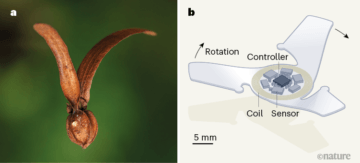E. Farrell Helbling in Nature:
 In a paper in Nature, Kim et al.1 report 3D fliers that are inspired by the passive, helicopter-style wind-dispersal mechanism of certain seeds. The adopted production processes enable the rapid parallel fabrication of many fliers and permit the integration of simple electronic circuits using standard silicon-on-insulator techniques. Tuning the design parameters — such as the diameter, porosity and wing type — generates beneficial interactions between the devices and the surrounding air. Such interactions lower the terminal velocity of the fliers, increase air resistance and improve stability by inducing rotational motion. When combined with complex integrated circuits, these devices could form dynamic sensor networks for environmental monitoring, wireless communication nodes or various other technologies based on the network of Internet-connected devices called the Internet of Things.
In a paper in Nature, Kim et al.1 report 3D fliers that are inspired by the passive, helicopter-style wind-dispersal mechanism of certain seeds. The adopted production processes enable the rapid parallel fabrication of many fliers and permit the integration of simple electronic circuits using standard silicon-on-insulator techniques. Tuning the design parameters — such as the diameter, porosity and wing type — generates beneficial interactions between the devices and the surrounding air. Such interactions lower the terminal velocity of the fliers, increase air resistance and improve stability by inducing rotational motion. When combined with complex integrated circuits, these devices could form dynamic sensor networks for environmental monitoring, wireless communication nodes or various other technologies based on the network of Internet-connected devices called the Internet of Things.
So far, research into collectives of aerial vehicles has been focused on active systems, including quadcopters2,3 and insect- or bird-inspired robotic platforms4. Active systems have the benefit of being able to move independently through their environment. However, their practical applications are limited because of the size and safety concerns of larger platforms (such as quadcopters, which have a wingspan of about 50 centimetres) and lack of onboard electronics and power supplies that enable autonomous locomotion in real-world settings in the case of smaller platforms (with a wingspan of roughly 3.5 cm)5. Furthermore, because these research platforms5–7 are highly specialized and assembled by hand, they cannot be used for studies of collective systems.
More here.
